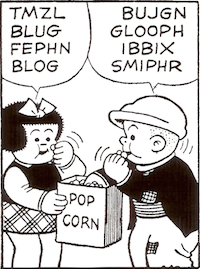On vacation earlier this week, Elaine and I went with friends into what New Jerseyans call "the city" to see the World Trade Center site. I had the chance to go to the site in the March 2002, when I made a short trip to New York to see an exhibit of Henry Darger's work and hear John Ashbery read from his Darger-inspired Girls on the Run. But in 2002, I chose not to go downtown. I had plenty of memories of staying up until two or three in the morning, watching the WTC site on television. Not going felt like an act of resolve: I didn't need to see what I knew had happened. But now going to the World Trade Center felt like a necessary trip. Our friends had been to the site not long after September 11, and they were willing to go again. So we drove into Manhattan on Father's Day morning, found a parking space just a block away, and walked over.
The area where the World Trade Center stood is fenced off, and much of the fencing is covered with tarp, to render the site unviewable in areas where pedestrians would impede the flow of traffic. We walked to the corner of Church Street and Vesey Street, where there is room for perhaps ten people at a time to stand and look through an open section of fencing. Whatever you already know that you know about September 11, 2001, it is difficult to understand the scale of destruction without seeing it. The hole in the ground, filled with movable roadways and heavy equipment, is massive. I looked down and then looked up, trying to grasp the size of the towers and the loss of life in what was, really, a city within a city. I imagine that this experience is a common one — looking down at what's there, looking up at what's not there, and turning away in grief.
We crossed Church Street to look at the graveyard of St. Paul's Chapel, the colonial gravestones worn, mostly, beyond legibility. The church was open, with people going in and out, and I thought of Philip Larkin's poem "Church Going" and the irony of a church — on Sunday morning — as a spot for tourists. But there was, to our surprise, a service underway. A sign near the doorway encouraged visitors to enter at any time, and a guard was beckoning people to come in. The small congregation (perhaps seventy people) sat in a circle, surrounding two celebrants at an altar. Exhibits documenting the aftermath of September 11 ran down the sides of the church: a cot used by those working in "the pit," a cross made of two pieces of metal recovered from the site, a gathering of memorial cards and photographs left at St. Paul's, words of sorrow and consolation in Chinese, English, French, Japanese, Portuguese, Spanish (and no doubt many other languages). There were letters and drawings for firefighters from New York schoolchildren: "Thank you for putting out the fire." Above, a banner, perhaps twenty feet long, filled with signatures: "TO NEW YORK CITY AND ALL THE RESCUERS: KEEP YOUR SPIRITS UP … OKLAHOMA LOVES YOU!!" The congregation stood to sing a closing hymn (accompanied by grand piano and hand drum), and the people who'd come in to look around stood and listened. Coffee and baked goods were available for anyone interested.
We crossed back and walked the rest of the perimeter of the World Trade Center site, on Church Street, then on Liberty Street, and then from inside Two World Financial Center, amid marble and palm trees, looking at the site through glass: all this splendor on one side of the window, all that tragedy on the other. When we went back to Vesey Street, a New York City policeman was taking a photograph for two beautiful and beautifully dressed young women, standing in front of the fence and smiling.
Friday, June 20, 2008
At the World Trade Center
and St. Paul's Chapel
By
Michael Leddy
at
10:51 AM
![]()
Subscribe to:
Post Comments (Atom)



comments: 0
Post a Comment